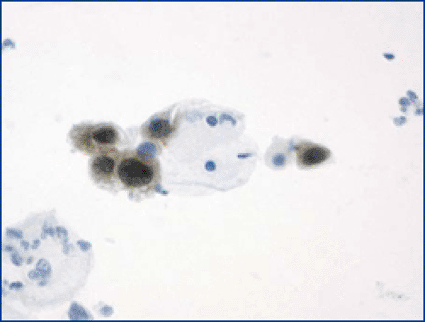Dual Staining Kit Identifies High Grade Cervical Disease
By LabMedica International staff writers
Posted on 07 Jun 2010
A staining test is capable of identifying the underlying causes of high-grade cervical disease among women who are negative on the Papanicolau test (Pap smears). Posted on 07 Jun 2010
The test uses advanced biomarkers to stain the cervical epithelium of women whose Pap smear results were equivocal but who were positive for Human papillomavirus (HPV). The smears are double stained with two immunoreactive markers revealing diagnostic proteins.

Image: Cells from cervical intraepithelial neoplasia. Cytoplasmic and nuclear positivity for p16INK4a in dysplastic cells (photo courtesy mtm laboratories).
The codetection of the cell cycle regulatory protein p16 INK4a (p16) and a marker for cell proliferation Ki-67 in a single cell can be used as a screening test for high-grade cervical disease. Their presence in a single cell is an indicator of cell cycle deregulation that occurs during High Risk-HPV (HR-HPV) induced oncogenic transformation. The test is highly specific and highly sensitive for women most likely to have this condition. The test can be applied on conventional and liquid based cytology slides where brown cellular staining indicates p16 over-expression and red nuclear staining indicates Ki-67 expression.
In a prospective study of screening for cervical cancer in Germany, 427 women out of nearly 8,000 tested HPV positive when the Pap test was negative. These women were then managed with repeat testing and colposcopic examinations and biopsies as clinically indicated. Cervical smears from the same cases were tested with the dual staining method CINtecPLUS developed by mtm laboratories AG, (Heidelberg, Germany) and compared with the biopsy results. The test detected 91.9% of patients with cervical intraepithelial neoplasia (CIN), grade 2 (moderate dysplasia) and 96% of CIN grade 3 (severe dysplasia) cases.
The test is independent of age and HR-HPV infections. The results of the study were presented in May 2010 at the 5th European Congress of the European Federation for Colposcopy and Cervical Pathology in Berlin, Germany (EFC).
Robert J. Silverman, MA, the CEO of mtm laboratories stated, "the CINtec Plus kit is so accurate in detecting high grade disease in those women tested that they can immediately be followed up, while those who are negative can be triaged for routine testing."
Related Links:
mtm laboratories AG













